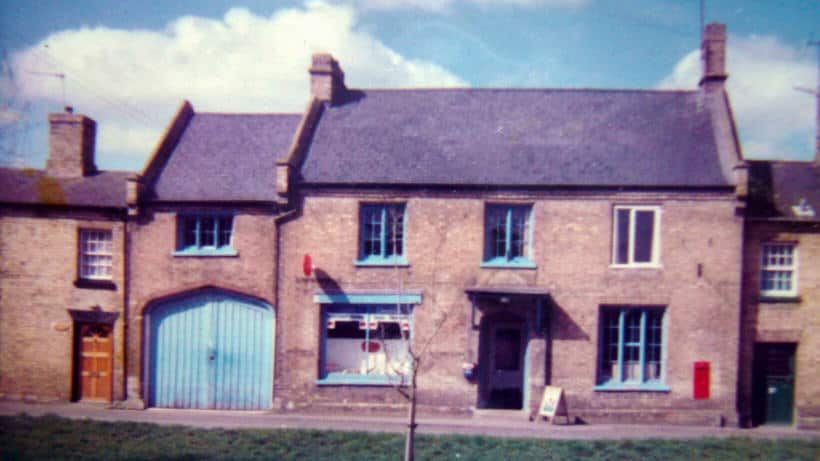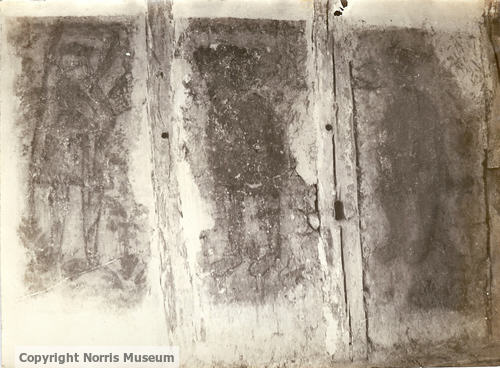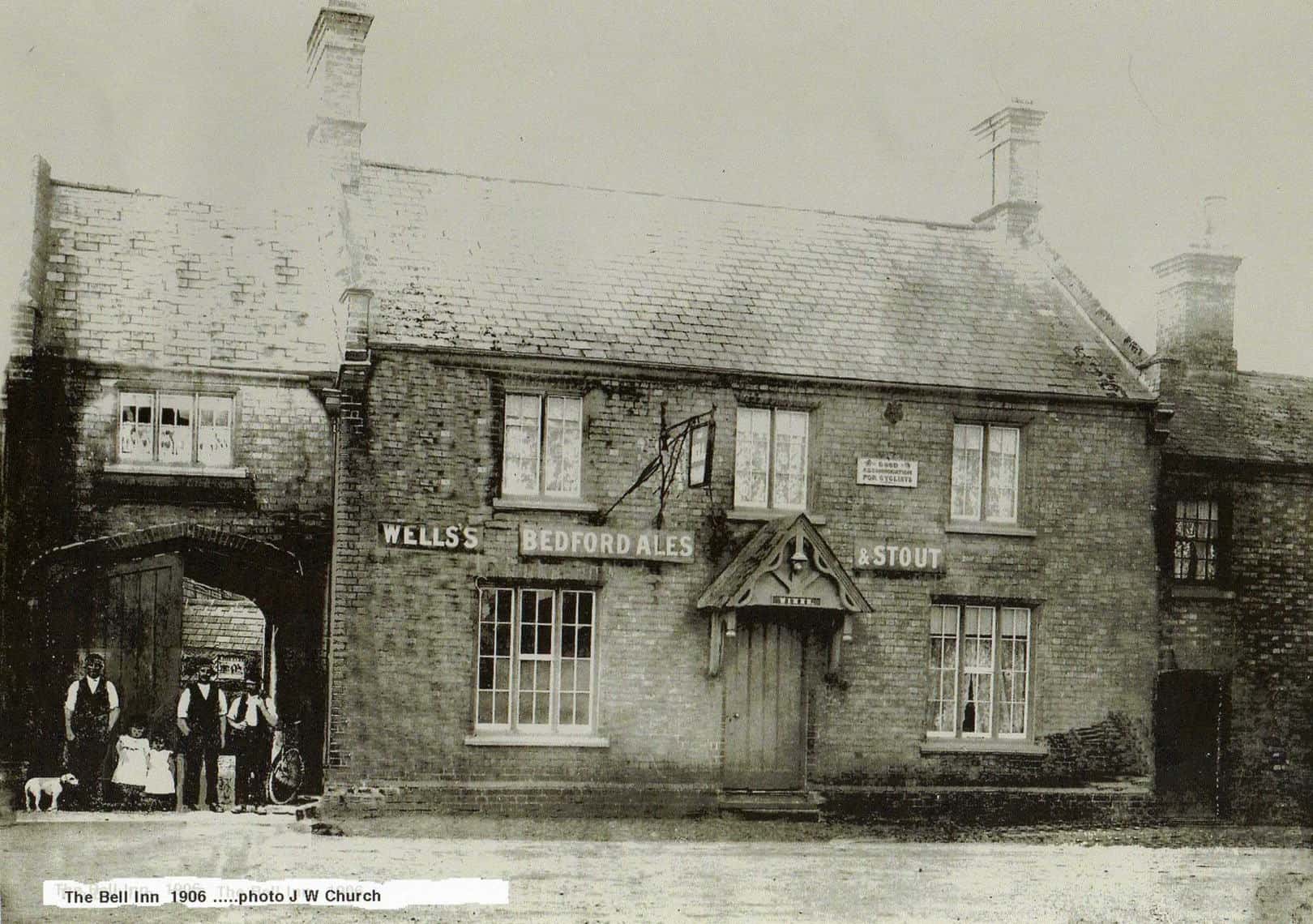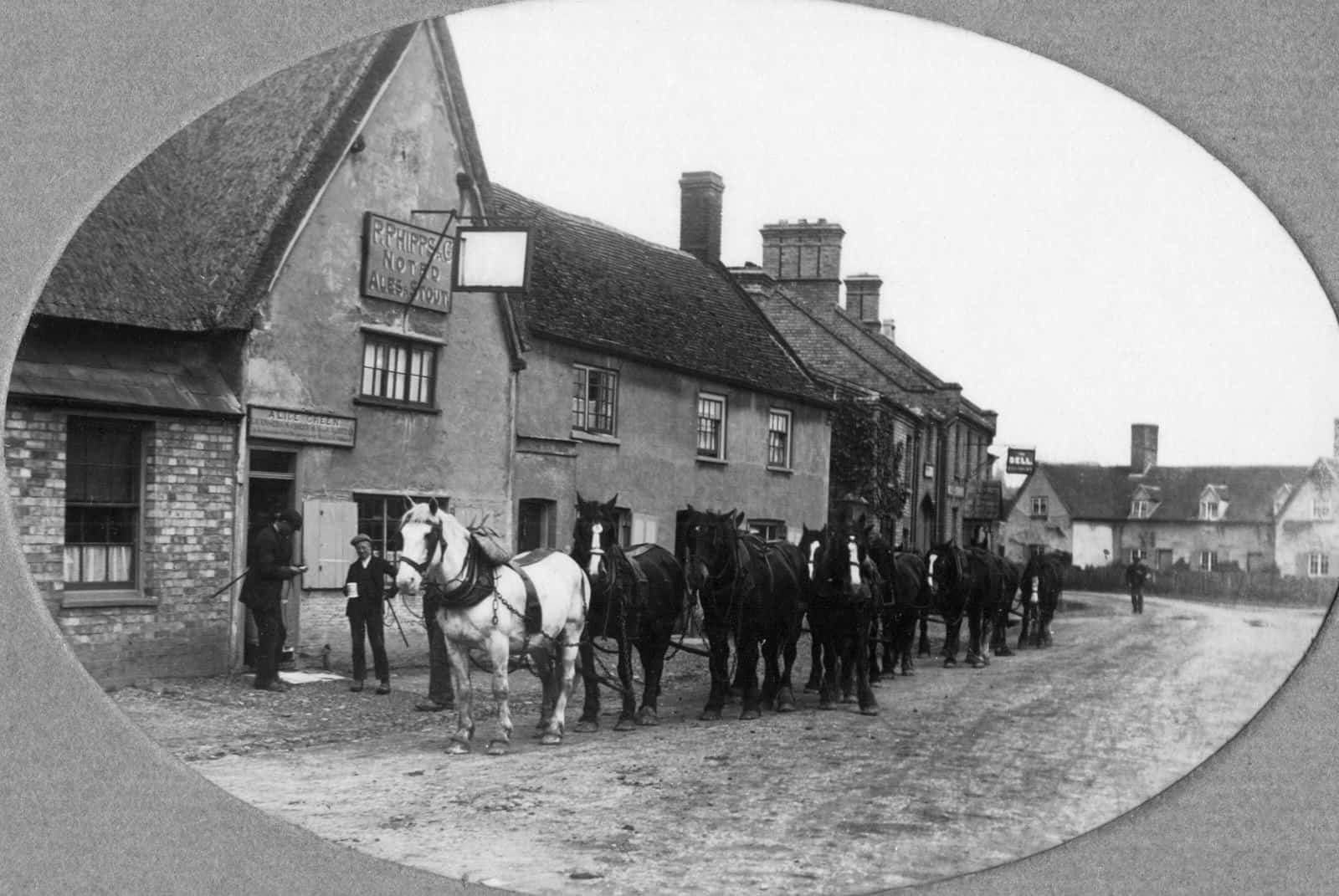There were three pubs in Spaldwick, all located on High Street, which was the main road from Kettering to Cambridge and Colchester. The George in Spaldwick – which is the only one that remains as a pub in the present day – was originally a house owned by the Darrington family in the 16th century and became a coaching inn in the late 17th century.
There were three pubs in Spaldwick
Around the time of the First World War, there were three pubs in Spaldwick, all located on the High Street, and these are all clearly identified in the 1911 Census:
- Bell Inn (formerly the Blue Bell Inn)
- George Inn
- Axe and Compasses Inn.
The Bell Inn
This information has been provided by Peter Absalom of Walton House in Spaldwick. Walton House has had a very interesting history – from being the Blue Bell Inn, the Bell and later the village Post Office and Shop.
Walton House was originally built as ‘The Blue Bell’ Inn and Public House. According to the earliest Victorian conveyance document in Peter Absalom’s possession, dated May 1876, the house – described as “The Blue Bell Public House and Fellmongers Yard” – was left by Robert Cook, fellmonger (defined as a “dealer in hides and skins – mainly sheepskins”) by his will of 11th January 1828 to his niece, Sarah Cook, daughter of his brother, William Cook.
Sarah was the wife of Thomas Braybrooks (also a Fellmonger). On Thomas Braybrook’s death in 1875, the property passed to their eldest son, William Braybrooks, whose rather handsome family marble gravestone is in Spaldwick churchyard. This document suggests that the Blue Bell was built sometime in the early 1820’s (if not earlier) and probably confirms the late Miss Davies’s description of its original function as a coaching inn, this being still the height of the coaching era.
The big double gates provide a typical passage through to a stable yard and there were formerly (listed in the 1876 Conveyance) additional buildings to the current barn and outhouses between the house and the Fellmongers Yard (now occupied by the close of modern houses behind Walton House). The adjoining cottages on each side were originally part of the same property. Indeed, the house is still linked to one of them by a disused cellar! The cottages were probably ostlers’ cottages. The name ‘Blue Bell’ is still common for ex coaching inns in Eastern England from Essex up to Yorkshire.
In 1876, William Braybrooks sold the Blue Bell to his tenant (and “wine merchant”) John Rogers, who kept it until 1888, when it was sold to the well-known brewers John Wells of Bedford and became “The Bell” public house. A 1906 photograph (below) shows it still offering “Good Accommodation for Cyclists”. One can still see through the archway some of the now demolished buildings behind.
In the 1911 Census, Harold James (aged 30) was the Licensed Victualler at the Bell Inn, who was also a bricklayer. He lived with his wife Florence James (31) and his young children Gladys James (5) and Laurence James (2). In 1914, the publican of The Bell was Daniel Nickerson.
The Bell remained a Wells pub until 1921 when it passed to another brewer, Marshall Brothers.
In 1925, the house finally ceased to be pub and became a shop – first a drapers and subsequently a grocers and general store, passing through the hands of a long series of owners.
By 1966, it was being described as “Waltons Stores” and by 1977 as “Stores and Post Office” (shown in the photo below). The last postmaster, Mr Ronald Carter, bought it in 1979 but, on the death of his wife in 1986, applied for the property to be re-designated as a dwelling house.
Spaldwick resident Vicky Wakefield said, “I remember Ron Carter. He was a jolly faced chap with a big grey beard! I used to bike down to the Post Office and buy penny sweets from him.”
The building was finally bought by the present owners in August 1997.

The George
Until 1539, when Henry VIII dissolved the monasteries, more than two-thirds of the land in Huntingdonshire belonged to The Church.
The Manor and Soke (jurisdiction) of Spaldwick – consisting of the parishes of Spaldwick, Easton and Stow Longa and the hamlet of Little Catworth – belonged to the Bishop of Lincoln and was administered by his steward, a member of the Darrington family, who lived in the Prebendal House (Manor House) in Stow Longa.
When the Bishop was forced to hand over his lands to the Crown, Darrington stayed on as Royal Steward until the property was finally sold. He built himself the large house at Spaldwick – now known as The George.
By 1584, the house was in the possession of William Bedell of Ellington. It may have been acquired from Richard Darrington some years before by his father (William of Easton), who was a considerable landowner. William Bedell of Ellington conveyed it to his younger brother, Edward Bedell of Easton.
The house remained in Edward Bedell’s family for nearly 100 years although it was let to other occupiers. His grandson – also named Edward – seems to have been the first Bedell to live in it himself.
In England, hearth tax was a tax imposed by Parliament in 1662 to support the Royal Household of King Charles II (following the Restoration of the monarchy in 1660). Edward Bedell was there is 1664 and 1674 when he paid eight shillings property tax (for its eight hearths) – by far the largest amount paid in Spaldwick. One shilling was liable to be paid for every firehearth or stove in the dwelling.
Part of the building seems to have been used as the village smithy.
On Edward Bedell’s death in 1676, it was inherited by his only child Frances and her husband Robert King, who opened it as The George Inn, and as such it was conveyed in 1679 to William Piggott.
It was probably in William Piggott’s time that it became a coaching stage. The George Inn was located on the main road from Kettering to Cambridge and Colchester.
In the 1911 Census, John Dew (aged 49) – who was born in Alconbury – was the Inn Keeper of the George Inn. He lived at The George with his wife Emma Dew (47) and children John Robert Dew (19) and Emma Daisy Dew (17).
 The photo (left), taken in April 1938, shows three areas of fresco at The George, and was kindly provided by the Norris Museum.
The photo (left), taken in April 1938, shows three areas of fresco at The George, and was kindly provided by the Norris Museum.
On the back of the photo is written, “Frescoes, The George Inn, Spaldwick – April 1938. Ex. J.R. Garrood”. J. R. Garrood was the Curator of the Huntingdon Museum, which closed in the 1950s.
The Axe and Compasses
Below is a photo of the Axe and Compasses Inn taken by Rev Holland before 1899. You’ll see the name plate above the door bears the name of the landlady – Mrs Alice Green. You can see the sign of The Bell Inn in the distance.
In the 1911 Census, the “Licensed Victualler” living at the Axe Inn was Percy Robert (aged 44), who was born in Chesterfield, Derbyshire, and was married to Martha Jane Robert. In 1914, the publican of the Axe was Henry Banks.



